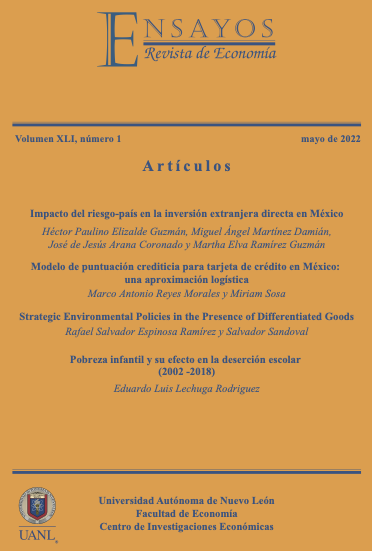Credit Scoring Model for Credit Card in Mexico: A Logit Approach
Modelo de puntuación crediticia para tarjeta de crédito en México: una aproximación logística
DOI:
https://doi.org/10.29105/ensayos41.1-2Keywords:
credit scoring; credit card; Mexico; logit modelAbstract
Credit risk is one of the main concerns of financial institutions and supervision and regulation organisms. Thus, a credit scoring model is proposed based on the logit approach to analyze the default risk for a credit card portfolio in a Mexican financial institution. Findings show that the model proposed has a high level of prediction and stability, in and out of the sample. The monotonicity property provides evidence that the model has a high level of precision. The originality lies in the fact that there is scarce literature on credit scoring models for Mexico. The model results are highly accurate in terms of predictability and the evidence is presented in a scoring table that is easy to interpret for all bank employees. We conclude that the model is reliable and highly accurate.
Downloads
References
Alaka, H. A., Oyedele, L. O., Owolabi, H. A., Kumar, V., Ajayi, S. O., Akinade, O. O., & Bilal, M. (2018). Systematic review of bankruptcy prediction models: Towards a framework for tool selection. Expert Systems with Applications, 94, 164-184. DOI: https://doi.org/10.1016/j.eswa.2017.10.040
Ampountolas, A., Nyarko Nde, T., & Constantinescu, C. (2021). A Machine Learning Approach for Micro-Credit Scoring. Risks, 9(3), 50. DOI: https://doi.org/10.3390/risks9030050
Ansari, A., Ahmad, I. S., Bakar, A. A., & Yaakub, M. R. (2020). A hybrid metaheuristic method in training artificial neural network for bankruptcy prediction. IEEE Access, 8, 176640-176650. DOI: https://doi.org/10.1109/ACCESS.2020.3026529
Byström, H. (2019). Blockchains, real-time accounting, and the future of credit risk modeling. Ledger, 4. DOI: https://doi.org/10.5195/ledger.2019.100
Caruso, G., Gattone, S. A., Fortuna, F., & Di Battista, T. (2021). Cluster Analysis for mixed data: An application to credit risk evaluation. Socio-Economic Planning Sciences, 73, 100850. DOI: https://doi.org/10.1016/j.seps.2020.100850
Chuang, C. L., & Lin, R. H. (2009). Constructing a reassigning credit scoring model. Expert Systems with Applications, 36(2), 1685-1694. DOI: https://doi.org/10.1016/j.eswa.2007.11.067
Devi, S. S., & Radhika, Y. (2018). A survey on machine learning and statistical techniques in bankruptcy prediction. International Journal of Machine Learning and Computing, 8(2), 133-139. DOI: https://doi.org/10.18178/ijmlc.2018.8.2.676
Ignatius, J., Hatami-Marbini, A., Rahman, A., Dhamotharan, L., & Khoshnevis, P. (2018). A fuzzy decision support system for credit scoring. Neural Computing and Applications, 29(10), 921-937. DOI: https://doi.org/10.1007/s00521-016-2592-1
Medina-Olivares, V., Calabrese, R., Dong, Y., & Shi, B. (2021). Spatial dependence in microfinance credit default. International Journal of Forecasting. DOI: https://doi.org/10.1016/j.ijforecast.2021.05.009
Papouskova, M., & Hajek, P. (2019). Two-stage consumer credit risk modelling using heterogeneous ensemble learning. Decision support systems, 118, 33-45. DOI: https://doi.org/10.1016/j.dss.2019.01.002
Puertas Medina, R. M., & Martí Selva, M. L. (2013). Análisis del credit scoring. RAE-Revista de Administração de Empresas, 53(3), 303-315. DOI: https://doi.org/10.1590/S0034-75902013000300007
Siddiqi, N. (2017). Intelligent credit scoring: Building and implementing better credit risk scorecards. John Wiley & Sons. DOI: https://doi.org/10.1002/9781119282396
Torvekar, N., & Game, P. S. (2019). Predictive analysis of credit score for credit card defaulters. Int. J. Recent Technol. Eng, 7(1), 4.
Trejo-García, J. C., Ríos-Bolívar, H., & Martínez-García, M. Á. (2016). Análisis de la administración del riesgo crediticio en México para tarjetas de crédito. Revista mexicana de economía y finanzas, 11(1), 103-121. DOI: https://doi.org/10.21919/remef.v11i1.79
Vega Mena, M. D. L., Santoyo Cortés, V. H., Muñoz Rodríguez, M., & Altamirano Cárdenas, J. R. (2017). Reducción de costos de transacción e información asimétrica: experiencias de financiamiento rural en México. Estudios sociales (Hermosillo, Son.), 27(49), 181-209.
Zhang, Y., Liu, R., Heidari, A. A., Wang, X., Chen, Y., Wang, M., & Chen, H. (2021). Towards augmented kernel extreme learning models for bankruptcy prediction: algorithmic behavior and comprehensive analysis. Neurocomputing, 430, 185-212. DOI: https://doi.org/10.1016/j.neucom.2020.10.038
Downloads
Additional Files
Published
How to Cite
Issue
Section
License
Copyright (c) 2022 Marco Antonio Reyes Morales, Miriam Sosa

This work is licensed under a Creative Commons Attribution 4.0 International License.
















